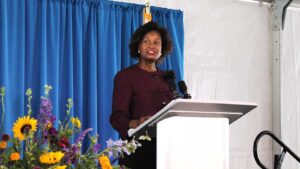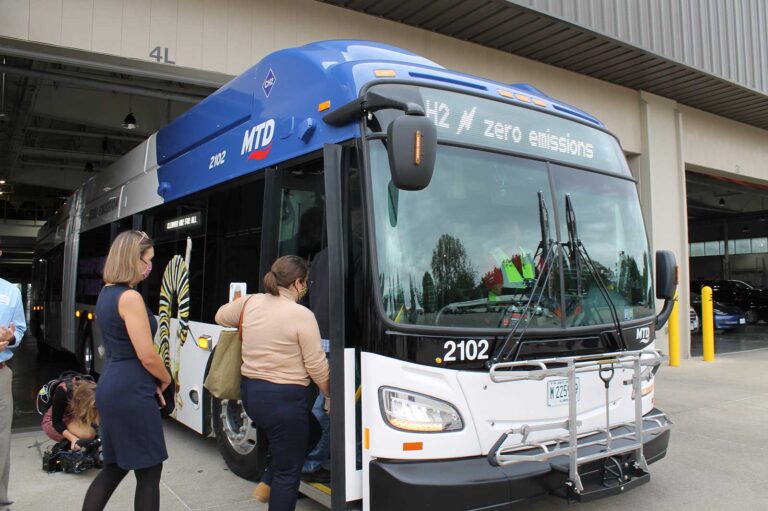CHAMPAIGN — Sunlight and water power two new buses in the Champaign-Urbana Mass Transit District fleet.
Champaign-Urbana is one of the first transit agencies in the country to adopt zero-emissions, hydrogen buses.
“I’ve always been a big science fiction fan,” said the district’s managing director, Karl Gnadt. “Now, this isn’t quite Star Trek-level technology. But it’s on the path to Star Trek-level technology.”
The Champaign-Urbana Mass Transit District (MTD) unveiled the two hydrogen fuel cell buses to much fanfare last week. Over a hundred people, including state and federal leaders, gathered under a white tent at the MTD maintenance station on Thursday.

Federal Transit Administration head Nuria Fernandez stepped up to the podium to laud the transit agency for leading the way for other bus systems.
“MTD is certainly at the cutting edge, because this is going to emit only water vapor instead of greenhouse gases and that is what’s leading the way in the fight against climate change,” Fernandez said.
Hydrogen fuel cells split hydrogen molecules into protons and electrons. The electrons provide an electrical current – and eventually reunite with the protons and other oxygen molecules to become water.
This chemistry-equation-laden tech has existed since the 1960s in cars, with a more recent revival in the 1990s. Hydrogen fuel cell buses are slightly newer and exist mostly in California and abroad.
While often hailed as a green technology, hydrogen power is not necessarily zero or low emissions. In fact, most hydrogen comes from mining natural gas, which releases greenhouse gases.
Champaign-Urbana is among the few places with a truly zero emissions process. The transit agency has its own electrolyzer, a device that splits water into hydrogen and oxygen using solar power.
Millions And Billions For Transit
Creating MTD’s new buses and fuel pump required large chunks of government dollars, including $1.45 million in 2018 from the Federal Transit Administration’s Low or No-Emission (Low-No) Bus Program.
That investment is well worth it, U.S. Senator Dick Durbin told the crowd assembled at MTD.
“These buses might cost a little more to begin with. But in the long run, they cost less to maintain, less to charge, and certainly are kinder to the environment,” Durbin said.
Durbin took a moment within his speech to promote President Joe Biden’s infrastructure bill. This bill would include $5.25 billion for the Low or No-Emission Bus Program over a three-year period, well above the totals for past years.
Other Illinois transit authorities, including those in Chicago, Rock Island County and Peoria, have won grants from the Low-No Program since Champaign-Urbana’s win. These other districts either specified that they would purchase electric battery buses – hydrogen buses’ more common cousins — or did not specify the kind of electric bus.
U.S. Representative Rodney Davis (R-Taylorville) also spoke at the event as a rare Republican passionate about transit.
“What we’re seeing here today is exactly why the United States of America is leading the way and making sure we reduce our carbon footprint and our emissions in this country,” Davis said.
They’re Hiring
At the same time that MTD is rolling out a potential bus of the future, its operations are lagging due to a problem of the present – COVID-19 worker shortages.
The Champaign-Urbana Mass Transit District has roughly 30 open positions. On any given day, an additional 20 drivers are out for COVID-19-related reasons. MTD’s Karl Gnadt said a driver might have caught COVID, or have a sick family member.
“Sometimes the child had a positive in their class, and so they go remote. Then they’ve got to stay home with their child. It’s a myriad of different reasons that that can be tangential to COVID,” Gnadt said.
The district has seen a higher number of retirements this year and a lower number of job applicants. It’s a situation seen across the county among different employers. Closer to home, Danville Mass Transit has also reported a shortage of drivers, resulting in service reductions.
MTD is slowly hiring to fill the gaps. Gnadt said the agency has to balance keeping veteran drivers on their routes with the need to pull them away to train the new hires.
In the meantime, buses on the district’s highest frequency routes – usually around the University of Illinois campus – come slightly less frequently. The wait time between buses has changed from 10 minutes to 15 minutes, Gnadt said.

